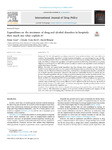Mostrar o rexistro simple do ítem
Expenditure on the Treatment of Drug and Alcohol Disorders in Hospitals: How Much and What Explains It?
| dc.contributor.author | Casal, Bruno | |
| dc.contributor.author | Costa Storti, Claudia | |
| dc.contributor.author | Morgan, David | |
| dc.date.accessioned | 2024-01-12T17:08:26Z | |
| dc.date.issued | 2020 | |
| dc.identifier.citation | Casal, B., Storti, C. C., & Morgan, D. (2020a). Expenditure on the treatment of drug and alcohol disorders in hospitals: How much and what explains it? International Journal of Drug Policy, 79, 102750. 10.1016/j.drugpo.2020.102750 | es_ES |
| dc.identifier.issn | 0955-3959 | |
| dc.identifier.uri | http://hdl.handle.net/2183/34888 | |
| dc.description.abstract | [Abstract] Background: The role of hospitals in providing treatment for drug and alcohol abuse varies markedly across countries. Knowing public expenditure on drug treatment in hospitals is an essential input for any cost-effectiveness and policy analysis. However, information on the level and trend in spending is often unavailable. This study aims firstly to estimate the expenditure on hospital treatment for illicit drug and alcohol use as primary diagnoses across Europe for the 2013–2015 period, secondly to explain recent expenditure trends and lastly to analyse their impact on policy. Methods: The study uses annual health expenditure data from Eurostat which complies with the ‘System of Health Accounts’ framework and covers the countries of the European Union as well as Norway. Data on hospital activities exist for ‘Mental and Behavioural Disorders’, which includes a breakdown into disorders caused by the use of alcohol and other psychoactive substances. The study uses ‘attributable fractions’ to estimate the proportion of hospital expenditure allocated to drug and alcohol treatments, based on data about this activity. Last, but not least, a panel data approach for the 2006–2015 period is used to explain expenditure determinants. Results: In 2015, it is estimated that EUR 5.8 thousand million and EUR 2.9 thousand million were spent on the treatment of alcohol and drug disorders in hospitals as primary diagnoses, respectively, for a set of 24 European countries with available data. Cross-country differences can be explained by the level of income, the burden of disease and the structures of health systems – for instance, the proportion of public spending and the level (or share) of resources allocated for outpatient care. Conclusion: These estimates allow a better evaluation of treatment provision and, therefore, a better allocation of scarce resources. This information can support service providers, health policymakers and taxpayers. In this sense, it is a first step in developing policy evaluation and cost-effectiveness analysis. | es_ES |
| dc.language.iso | eng | es_ES |
| dc.publisher | Elsevier | es_ES |
| dc.relation.uri | https://doi.org/10.1016/j.drugpo.2020.102750 | es_ES |
| dc.rights | © 2020 Elsevier B.V. All rights reserved | es_ES |
| dc.subject | Hospital treatment | es_ES |
| dc.subject | Health expenditure | es_ES |
| dc.subject | Drug use | es_ES |
| dc.subject | Alcohol use | es_ES |
| dc.subject | Diagnoses | es_ES |
| dc.subject | Top-down approach | es_ES |
| dc.title | Expenditure on the Treatment of Drug and Alcohol Disorders in Hospitals: How Much and What Explains It? | es_ES |
| dc.type | info:eu-repo/semantics/article | es_ES |
| dc.rights.access | info:eu-repo/semantics/embargoedAccess | es_ES |
| dc.date.embargoEndDate | 9999-99-99 | es_ES |
| dc.date.embargoLift | 10007-06-07 | |
| UDC.journalTitle | International Journal of Drug Policy | es_ES |
| UDC.volume | 79 | es_ES |
| dc.identifier.doi | https://doi.org/10.1016/j.drugpo.2020.102750 |






